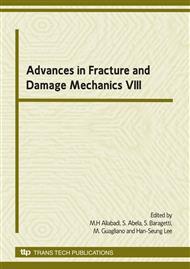p.93
p.97
p.101
p.105
p.109
p.113
p.117
p.121
p.125
The Analysis of Microrack Tip Plastic Zone Formed in Thin Films after LCF Tests of Austenitic Steel Used in NPP I
Abstract:
The study deals with the TEM characterization of samples after low-cycle fatigue (LCF) tests of austenitic stainless steels used in nuclear power plants (NPP). Microcracks are observed in the TEM thin films prepared from standard cylindrical bulk samples. In plastic zones, at the tips of microcracks, several three-dimensional crystal structure defects are detected: 1. Arched extinction contours, 2. Zone of disorientations, 3. Deformation twins of different orientations, 4. Short micro cracks deviated from the main crack direction. The above defects have been studied using TEM, including micro-diffraction; trace analysis and dark-field techniques. It is shown that the microcrack and the created defects represent the means of relaxation of elastic stresses retained in the sample after LCF. It is also shown that redistribution of stresses leads to the nucleation of microcracks and subsequent creation of all the observed defects. A dislocation scheme of the stresses, detected by the extinction contours at microcrack tip, is proposed. The comparison of the proposed scheme of stress distribution with the TEM micrographs shows a good resemblance. Consequently, a topology of stress distribution at microcrack tip - before formation of plastic zone - is determined. The shape represents a three-leaved figure. Compliances and differences between the proposed scheme and the experimentally observed defects and plastic zone size are discussed based on crystallographic analysis of the respective electron diffraction patterns.
Info:
Periodical:
Pages:
109-112
Citation:
Online since:
October 2009
Authors:
Keywords:
Price:
Сopyright:
© 2010 Trans Tech Publications Ltd. All Rights Reserved
Share:
Citation:


